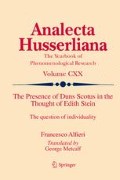Abstract
I shall now present the conclusion to this study, bearing in mind the objectives set out in the Introduction.
Access this chapter
Tax calculation will be finalised at checkout
Purchases are for personal use only
Notes
- 1.
- 2.
Having already tackled these issues in other studies, I made reference to the parallel doctrines of Conrad-Martius on individuation. For a treatment of this point the reader is referred to Alfieri F. (2010).
- 3.
Stein E. (2008), p. 54. English translation, p. 38.
- 4.
See De Monticelli R. (2006), p. 364.
- 5.
See ibid.
- 6.
With no wish to conduct a polemic, I would like to point out here that although it does cite Leibniz, De Monticelli’s analysis lacks any reference to Stein, which however at this point is essential. Given the “classical” nature of the theme of depth in Stein’s works, suitable references to her would perhaps have been more relevant than a comparison with authors such as van Inwagen and Baker, on whose “classical” nature history has yet to give its verdict. Furthermore, there is an evident close affinity between the concepts deployed by De Monticelli, including “depth” and the “hidden reality” of the soul (See ibid. p. 362), with the Steinian notions of ultima solitudo, interior castle (Seelenburg), depth of the soul, etc.
- 7.
Ales Bello A. (2012), p. 38 (our translation).
References
Ales Bello, A. (2012). Status quaestionis. In A. Ales Bello & P. Manganaro (Eds.), … e la coscienza? Fenomenologia, Psico-patologia, Neuroscienze (Cerchi concentrici (III), pp. 13–39). Bari: Edizioni Giuseppe Laterza.
Alfieri, F. (2010). Il principio dell’individuazione nelle analisi fenomenologiche di Edith Stein e Hedwig Conrad-Martius. Il recupero della filosofia medievale. In A. Ales Bello, F. Alfieri, & M. Shahid (Eds.), Edith Stein e Hedwig Conrad-Martius. Fenomenologia Metafisica Scienze (pp. 143–197). Bari: Edizioni Giuseppe Laterza.
De Monticelli, R. (2006). Persona e individualità essenziale. Un dialogo con Peter van Inwagen e Lynne Baker. In M. Cappuccio (Ed.), Neuro-fenomenologia. Le scienze della mente e la sfida del-l’esperienza cosciente (pp. 341–378). Milan: Paravia Bruno Mondadori.
Stein, E. (2008). Zum Problem der Einfühlung. Eingeführt und bearbeitet von M. A. Sondermann. ESGA (5). Freiburg/Basel/Wien: Herder. English edition: Stein, E. (1989). On the Problem of Empathy (trans: Stein, W.). The Collected Works of Edith Stein (III); Introduction to the third edition by M.C. Baseheart. Washington, DC: ICS Publications.
Author information
Authors and Affiliations
Rights and permissions
Copyright information
© 2015 Springer International Publishing Switzerland
About this chapter
Cite this chapter
Alfieri, F. (2015). Conclusion. In: The Presence of Duns Scotus in the Thought of Edith Stein. Analecta Husserliana, vol 120. Springer, Cham. https://doi.org/10.1007/978-3-319-15663-7_5
Download citation
DOI: https://doi.org/10.1007/978-3-319-15663-7_5
Published:
Publisher Name: Springer, Cham
Print ISBN: 978-3-319-15662-0
Online ISBN: 978-3-319-15663-7
eBook Packages: Humanities, Social Sciences and LawPhilosophy and Religion (R0)

